| Jensen Motors Limited Jensen was founded by two brothers,
Alan and Richard Jensen, who were born in 1906 and 1909.
They became interested in cars at an early age, and so
in 1930 their father set them up in their first
business, Patrick Jensen Motors, based at Edgbaston.
They ran the business with Joe Patrick, but moved on the
following year after a disagreement.
In 1931 they started work at W. J.
Smith & Sons, an old established firm of motor body
builders, located in High Street, Carters Green, West
Bromwich. Smiths specialised in bodywork for lorries and
cars. After William Smith’s death the brothers took over
the business, and in 1934 it became Jensen Motors
Limited.
The business specialised in
custom-built bodies for a range of readily available car
chassis made by a range of manufacturers including
Morris, Singer, Standard, and Wolseley. In 1934 the
brothers received a commission from American actor Clark
Gable to him build a special car, on a Ford V8 chassis.
The brothers very much wanted to
manufacture their own cars and so work soon began on the
first model called the “White Lady”. The large open
tourer was powered by a 3.5litre Ford V8 engine and
appeared on the market in 1936. They also produced a
saloon version. Quite a few cars were built, but many
orders were also received for commercial vehicle bodies
for lorries, vans, and buses. In 1939 the first Jensen
lorry, the Jensen lightweight truck was launched. Built
for Reynolds Tubes, it used aluminium alloys, and was
powered by a 4.7 litre Perkins diesel engine. It had a
5-speed Moss gearbox.
After the war Jensen launched another lightweight
lorry, the JNSN, which was easily recognisable by the
radiator grille, shaped to the JNSN letters. It was available in a range of forms including
lorries, trucks, pantechnicons, and even as a luxury
coach. The vehicles sold well and remained in production
until 1956.
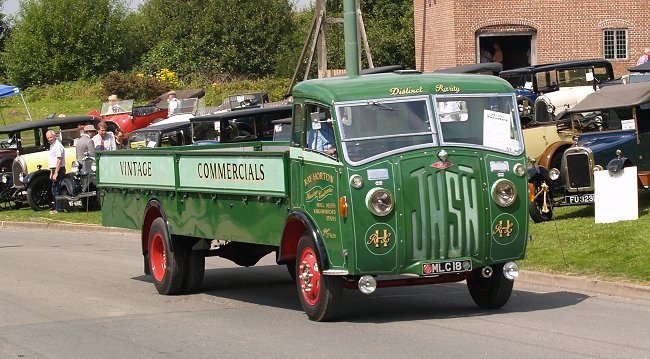
Ray Horton's JNSN Jensen lorry from 1951. At
the Black Country Living Museum in 2008.

A JNSN luxury coach.
In the late 1940s, production of another commercial
vehicle, the 'Jen-Tug' began. It was a 3 ton articulated
vehicle, available with a wide range of trailers,
including a flat trailer, a wire-sided trailer, a box
trailer, a tipping trailer, a shallow tipping trailer, a
high-sided trailer, a swan-neck trailer with winch, and
a container.
The cab had an Austin A.50 four-cylinder,
overhead valve petrol engine, with a capacity of 1.5
litres, and an output of 50 bhp. at 4,400 rpm. It
had a built-in four-speed synchromesh gearbox, a Borg &
Beck, single dry-plate 8 inch hydraulically operated
clutch, and was mounted on an easily removable
sub-frame. It also had powerful Girling hydraulic brakes
with 11 inch diameter drums on both the tractor and
trailer, a Jensen patent tractor coupling, operated from
the cab, and a turning circle of 22 feet.
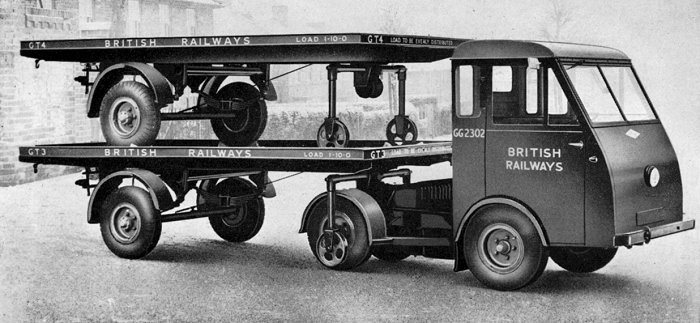
A 'Jen-Tug' with a flat bed trailer. From
the Jensen sales literature.
 |
The lightweight 'Jen-Tug' cab with the
engine sub-assembly removed for servicing. From the
Jensen sales literature. |
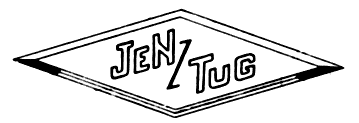
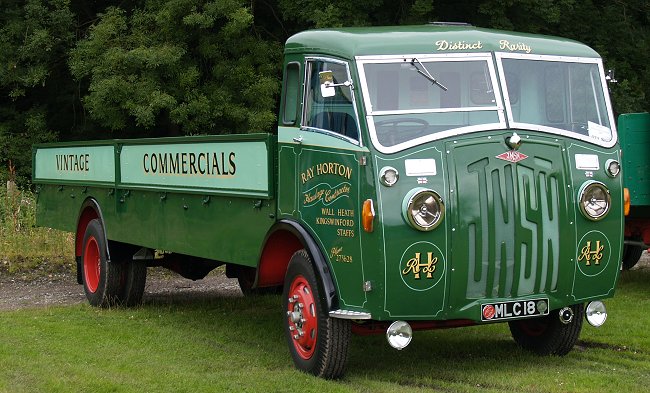
Another view of Ray Horton's JNSN lorry at the
Black Country Living Museum.
| The 'Jen-Tug' became quite popular, and was
supplemented by an electrically-powered version, the
'Jen-Helec'. The vehicles were made at West Bromwich,
and also in Jensen's factory at Stoke.
Jensen also built a number of German 'Tempo' 26 cwt.
front-drive trucks under licence, and bodies for the
four-wheel drive Austin Gipsy. |

A front view of Ray Horton's
lorry. |

A final view of Ray Horton's lorry.
During World War 2 the firm
concentrated on war work, building components for
military vehicles, including turrets for tanks.
Conversions were also carried out on American Sherman
tanks to turn them into amphibious vehicles.
After the war, car production
resumed with the launch of the Jensen ‘PW’ luxury
saloon, powered by a 3.86litre, 8 cylinder Meadows
engine. Unfortunately the engine suffered from excessive
vibration and so a replacement was essential.
The car didn’t go unnoticed. Soon
after making its appearance at the London motor show, a
remarkably similar design called the ‘Sheerline’ was
launched by Austin, much to the annoyance of Jensen.
Austin had been so impressed with the ‘PW’ that they
quickly produced an almost identical design. Heated
discussions followed between the two companies, and in
order to placate Jensen, Austin agreed to supply them
with ‘Sheerline’ engines, which could be used in the
‘PW’ as a replacement for the unsuitable Meadows unit.
This was to be the start of a long and successful
relationship between Austin and Jensen. |
|
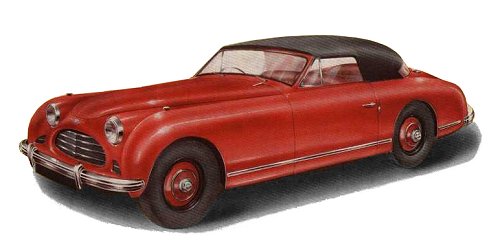
An early Interceptor. From sales
literature. |
Although the ‘PW’ remained in
production until 1952, only a small number were built,
partly due to the shortage of materials after the war.
In 1950 the Jensen ‘Interceptor’ name appeared for the
first time in the form of a modern coupé with a
lightweight body. The car, partly designed by Eric Neale,
an ex-Wolseley body designer who joined Jensen in 1946,
remained in production until 1958. |
| In 1953 Jensen launched a new model, the ‘541’ which
had a fibreglass body designed by Eric Neale, and sold
for £2,346. The car had many Austin components,
including the engine, to keep the price to a minimum.
The car continued in production until 1962 when it
was replaced by the ‘CV8’, a lightweight design, powered
by a Chrysler V8 engine. |
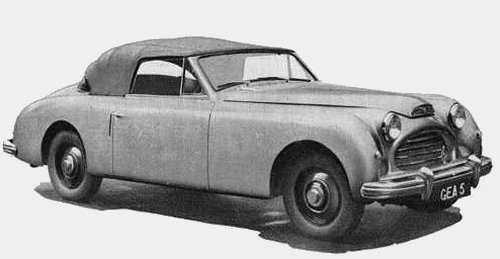
Another early Interceptor. From
sales literature. |
|

The combination of the lightweight design and the
powerful engine meant that the car had a top speed of
130m.p.h. A number of different versions were available
including the ‘F.F.’ four wheel drive that sold for
£5,249. The initials F.F. stood for Ferguson Formula,
named after Harry Ferguson the tractor designer who
invented the four wheel drive used in the car. Something
like 350 ‘CV8’s were built.

Denzil Partridge's Jensen bodied
Austin A40 Sports from 1952.
|
| In 1956 Jensen moved to a
new purpose built factory in Kelvin Way, West Bromwich
where they not only made cars but also continued to make
car bodies for other manufacturers, including Sunbeam
‘Tiger’ bodies for Rootes, and carried out finishing
work on ‘1800’ bodies for Volvo. They also made several
different bodies for Austin including the A40 Sports
model, the Austin Healey 100, and the ‘Gipsy’. Over
1,000 people were employed in the Kelvin
Way works. |
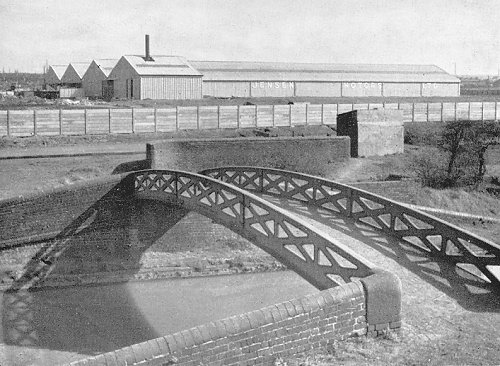
The new factory in Kelvin Way. |
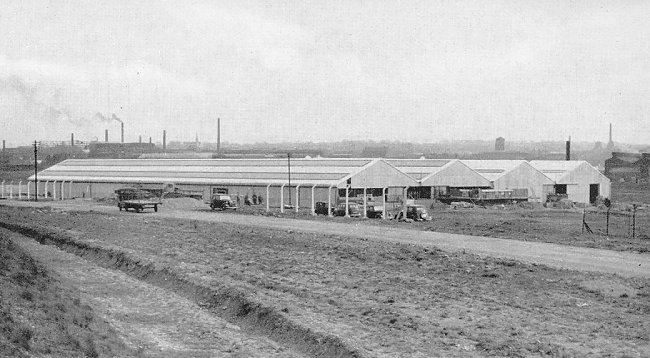
Another view of the new factory.
|

M. Webb's 4litre Jensen from 1956. |
In the late 1950s Jensen was taken
over by the Norcross Group which led to an awkward
relationship between Norcross and the Jensen brothers.
In 1965 the ‘CV8’ was replaced by
what would be Jensen’s most well known model, the
‘Interceptor’, a totally different car to the original
model bearing that name. The modern-styled body was
designed by the Italian coachbuilder Touring, and
initially built in Italy by Vignale, and later at Kelvin
Way. Several versions were available including a
convertible, a coupé, and a saloon. |

An advert from 1956.
|
In 1966 the ‘Interceptor’ was voted
‘Car of the Year’. Around 4,500 would be built.
Unfortunately the Jensen brothers,
now getting on in years, and not happy with the
direction the company was taking, especially with the
use of Italian bodies, decided to call it a day, and
retired from the business in 1966. |

Jason Taylor's MK3 Interceptor
from 1971. |
|

A MK3 Interceptor saloon. From
sales literature. |
In the late 1960s things started to go wrong. The
Austin Healey was discontinued and so Jensen lost a most
lucrative contract, the main source of income for the
company.
At the time body building work was in short supply,
and the business found itself in deep trouble. |
|

An interior view of the factory.
After the demise of the Austin Healey, Donald Healey
planned to build a new sports car as a replacement,
built by Jensen and aimed at the American Market.
Jensen’s dealer in California, Kjell Qvale, an extremely
successful American businessman, was greatly impressed
with Healey’s plans for the new car. As a result he
became Jensen’s major shareholder, and employed Donald
Healey as company chairman. The plans for the new car,
called the Jensen Healey rapidly got underway and the
car went into production in 1972. Unfortunately there
were faults in the design, and the build quality left a
lot to be desired. An improved version appeared the
following year, but Donald Healey disapproved, and
resigned. |
| Desperate efforts were made to improve the
situation, including cost-cutting which resulted in a
large number of redundancies. New up-market versions
of the ‘Intereceptor’ were launched including a
convertible and a coupé, but all to no avail.
Jensen’s financial situation worsened and a Receiver
was appointed in September 1975. Production continued
until Jensen Motors Limited went into liquidation in May
1976. |
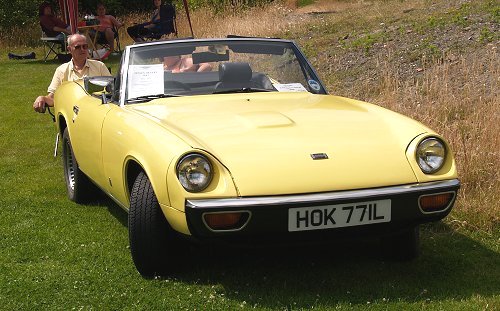
John Meredith's Jensen Healey from
1973. |
|

Another view of John Meredith's
Jensen Healey from 1973. |
The company was sold in two parts
to a holding company, Britcar Holdings. The two parts
were Jensen Special Products Limited, and Jensen Parts
and Service Limited.
Jensen Special Products Limited was
a specialised engineering and design company, mainly
formed from Jensen’s development department.
Unfortunately the venture failed after an unsuccessful
management buy-out. |
|
Jensen Parts and Service Limited
had been formed to service and renovate Jensen cars. It
became quite profitable and began to import Subaru, and
later Hyundai cars. Company employee Ian Orford, who had
purchased the right to the Jensen brand name, took the
business over in 1982 and it became Jensen Cars Limited.
He decided to restart production of the ‘Interceptor’
using the original jigs and readily available
components. The new Series 4 ‘Interceptor’ made its
first appearance at the 1983 Birmingham Motor Fair. The
car was almost identical the previous model, except that
it now had a Chrysler 5.9litre engine. The car sold for
around £45,000, but production never really got underway
and only a few were built.
In 1988 Ian Orford sold the
business to Unicorn Holdings of Stockport. Although
development work then started on a new model, the Series
5, it never came to fruition. After a round of
cost-cutting, a Receiver was appointed in 1992 which
resulted in the closure, and sale of the Kelvin Way
Site. In April 1993 Martin Robey, a manufacturer of
Jaguar body spares in Nuneaton purchased the design
rights, copyrights, tooling, stock of parts, and almost
the entire contents of the works. Some of the remaining
Jensen staff joined the Nuneaton workforce and the
business became Martin Robey Sales Limited. Their Jensen
and Jensen Healey works Parts Department still offers
parts from the original Jensen stock, and also
manufactures parts using the original tooling and
specifications.
In 1998 Creative Design Limited of
Redditch developed a new Jensen car, the ‘S-V8’.
Although a few were built, the project was unsuccessful
and ended in 2002. |
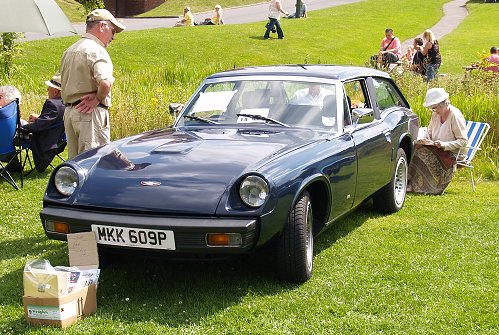
P. D. Bryan's immaculate Jensen Healey GT from
1975.
|
 |
Return to the
previous page |
|
|